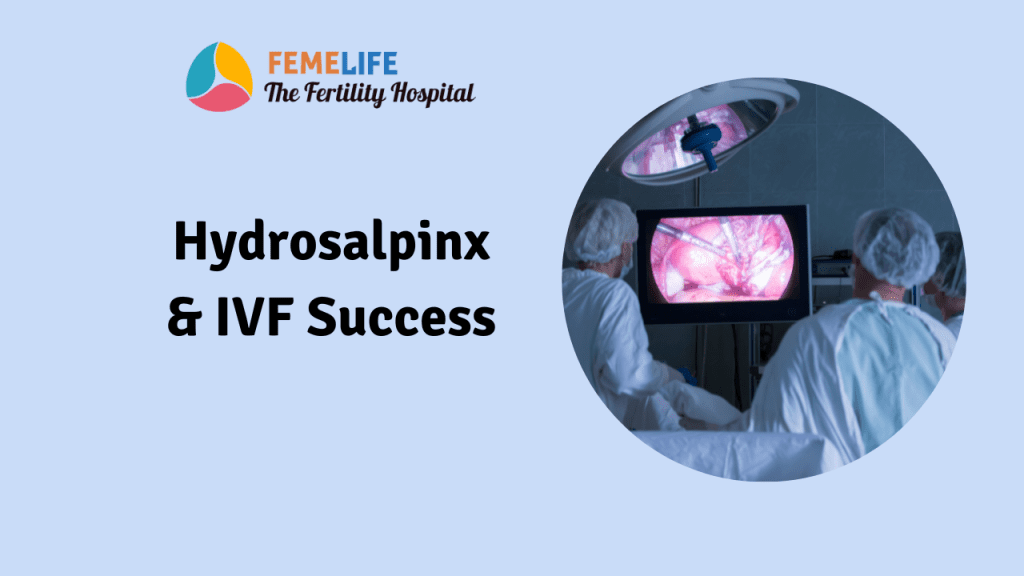Louise Brown, was born in 1978 in a natural cycle IVF of a woman who had bilateral tubal block. These women have IVF as the only option for having a child. Ealier, there was no hope for women with tubal problem to ever conceive their own child. The results of tubal reconstructive surgery in women with hydrosalpinx are not so satisfactory. These women have more chances of ectopic pregnancy after reconstructive surgeries. The advances in Assisted Reproductive Technologies (ART) are tremendous and accessible. Infertility treatment has become almost a routine procedure now a days.
What is a hydrosalpinx?
Swollen and fluid filled tubes are called hydrosalpinges. These tubes are usually blocked at the fimbrial end. However the uterine end may or may not be blocked. Since the fallopian tubes play a great part in natural conception , these women usually present with infertility. At times, ectopic pregnancy can result due to the hydrsalpinx.
- Hydrosalpinx is a common cause of female infertility.
- Lower implantation and pregnancy rates have been reported in women with hydrosalpinges.
- Effective treatment before IVF may be salpingectomy.
- Laparoscopic surgery is helpful for both diagnosis and management of the hydrosalpinx.
Causes of Hydrosalpinx
- Infection : Usually hydrosalpinx is caused by pelvic infection.
- Pelvic surgery
- Endometriosis
- Adhesions
- Growths and tumors
- Tuberculosis
Symptoms:
You may not have any symptoms untill your sonologist reveals it to you.
At times women may have
- White discharge
- Pain in the lower abdomen
- Abnormal bleeding
- Infertility
Types of Hydrosalpinges
Hydrosalpinx can be classified into
- Simple hydrosalpinx – a thin-walled with flattened mucosal folds without mucosal adhesions
- Hydrosalpinx follicularis, which is a thinwalled hydrosalpinx with mucosal adhesions
- Thick-walled hydrosalpinx with absent mucosal folds.
IVF with hydrosalpinges
The probability of achieving a pregnancy in the presence of hydrosalpinx is reduced by half. Hydrosalpinges may reduce the success rate of IVF due to the following reasons.
- The altered fluid movements caused by the junctional zone contractions during ovarian stimulation
- Toxicity of the fluid reduces implantation, the fluid contains various inflammatory substances like Epidermal growth factor (EGF), Tumor necrosis factor-α (TNF-α), Cytokines, Integrin β, Growth factors
- The incidence of spontaneous abortion is more with swollen tubes.
- Decrease in ovarian response due to the reduced blood supply
- Direct effect on the endometrium, leading to intrauterine fluid formation
- Alterations in endometrial receptivity markers, resulting in poor implantation
Is the hydrosalpinx fluid toxic?
In most instances the hydrosalpinx fluid is free of any infection. Pathogenic organisms are usually not there in this fluid. However, this contains many endotoxins and inflammatory substances which are toxic for the embryo. This fliud may wash out the embryo from the site of implantation or cause adverse reactions which prevent implantation.
How can hydrosalpinx affect endometrial receptivity?
The fluid in hydrosalpinges contain a lot of endotoxins and inflammatory products. This adversly affects the process of implantation. Since implantation depends on a state of molecular transmitors and chemical mediators, it can get disturbed by the endotoxins. High oxidative stress, fluid mechanics and imbalance in cytokines can retard the endometrial receptivity . This may lead to rejection of dialogue between the embryo and endometrium in the implantation window.
Can the fluid in the swollen tubes cause nutritional deficiency of the embryos transferred into uterus?
The blastocysts of the advanced state of embryos need glucose as their primary nutrition requirement. The hydrosalpinx fluid lacks nutrients and glucose. This leads to impaired development of the embryos and reduce the possibilities for implantation. Moreover the oxidative stress is higher due to various chemicals in this fluid. It adds to the nutritional deficiency of the starved embryos.
Suggestions to improve IVF Success
Salpingectomy before IVF : The hydrosalpinx that is visible on transvaginal sonography will require removal of the swollen tubes before IVF treatment. These tubes may enlarge more during ovarian stimulation. Infective fluid will deteiorate the endometrium for implantation.
What are the other treatment options?
Fimbrioplasty is helpful in patients with fimbrial occlusion usually with concurrent periadnexal adhesions. Choice of fimbrioplasty or salpingostomy depends on degree of occlusion.
The main advantage of laparoscopic surgery in the treatment of hydrosalpinx is that absence of the open wound . It has less postoperative discomfort and pain for the patient, shorter hospitalization time. Consequently, lower hospital cost and quicker resumption of normal activities makes this a preferred method.
Draining the fluid during oocyte retrieval – Your IVF specialist may prefer to aspirate the fluid during oocyte retrieval. In such an instance she will put you under antibiotic cover. Your embryo transfer will happen after 2-3 cycles of rest.
Hysteroscopic tubal occlusion – This treatment will help if your hydroslpinges are not too big or on single side. Blocking the uterine end of the tube prevents flow of the fluid into your uterus after embryo transfer. This is an alternative treatment to removal of the swollen tubes.
